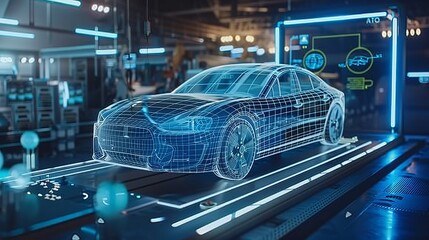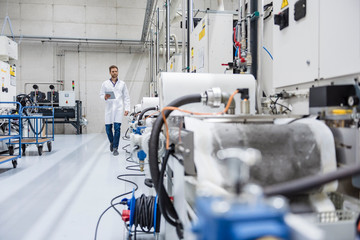Artificial Intelligence (AI) is rapidly transforming industries around the globe, and manufacturing is no exception. The integration of AI into manufacturing processes is not just a trend but a necessity for companies aiming to stay competitive in today’s fast-paced market. From enhancing production efficiency to reducing operational costs, AI offers a multitude of benefits that can revolutionize traditional manufacturing methods. In this article, we will explore how to use AI in manufacturing, the various applications of AI in this sector, and the advantages it brings to the table. Additionally, we’ll address some frequently asked questions (FAQs) to provide a comprehensive understanding of this technological advancement.
1. The Role of AI in Modern Manufacturing
AI in manufacturing is more than just automation; it’s about making systems smarter and more adaptive. Traditional manufacturing processes relied heavily on human intervention for decision-making and problem-solving. However, with AI, machines can learn from data, recognize patterns, and make decisions autonomously, leading to a more efficient production line.
AI’s role in manufacturing extends across various stages, including design, production, quality control, and supply chain management. By leveraging machine learning algorithms, manufacturers can predict equipment failures, optimize production schedules, and even personalize products according to customer preferences.
2. Key Applications of AI in Manufacturing
AI’s integration into manufacturing is vast, touching every aspect of the production cycle. Here are some of the key applications:
- Predictive Maintenance: One of the most significant advantages of AI is its ability to predict when equipment is likely to fail. By analyzing data from sensors and historical performance, AI can forecast maintenance needs, reducing downtime and extending the life of machinery.
- Quality Control: AI systems can detect defects and anomalies in products with greater accuracy than the human eye. Machine vision technology, powered by AI, allows for real-time quality assessment, ensuring that only the best products reach the market.
- Supply Chain Optimization: AI can optimize the entire supply chain by analyzing data related to inventory levels, demand forecasting, and supplier performance. This leads to reduced waste, better inventory management, and faster delivery times.
- Robotics and Automation: AI-driven robots are becoming more common in manufacturing. These robots can perform tasks that are dangerous or monotonous for humans, such as welding, assembling, or painting. Additionally, collaborative robots (cobots) work alongside human operators, enhancing productivity and safety.
- Design and Product Development: AI aids in the design process by analyzing customer feedback and market trends. It can suggest design improvements and even create new product prototypes faster than traditional methods.
3. The Benefits of Using AI in Manufacturing
The integration of AI into manufacturing processes offers a plethora of benefits, making it a game-changer for the industry:
- Increased Efficiency: AI-driven automation and predictive analytics streamline production processes, reducing bottlenecks and improving overall efficiency. This leads to faster production times and increased output.
- Cost Reduction: By optimizing production schedules and minimizing downtime, AI helps in reducing operational costs. Additionally, AI-powered quality control reduces the rate of defects, saving costs associated with rework and returns.
- Enhanced Product Quality: AI systems can monitor the production process in real time, ensuring consistent quality across all products. This not only enhances customer satisfaction but also strengthens brand reputation.
- Better Decision-Making: AI provides manufacturers with valuable insights derived from data. This enables better decision-making, from resource allocation to market strategy, ensuring that companies can respond quickly to changing market demands.
- Workforce Safety: AI-powered robots can take over dangerous tasks, reducing the risk of workplace accidents. Additionally, AI can monitor the working conditions and alert supervisors to potential hazards, further ensuring a safe working environment.
4. Overcoming Challenges in AI Implementation
While AI offers numerous advantages, its implementation in manufacturing comes with its own set of challenges. Understanding these challenges is crucial for a successful AI integration:
- High Initial Investment: Implementing AI requires a significant upfront investment in technology, infrastructure, and training. However, the long-term benefits often outweigh the initial costs.
- Data Security: With AI relying heavily on data, ensuring the security and privacy of sensitive information becomes paramount. Manufacturers need to adopt robust cybersecurity measures to protect their data from breaches.
- Skilled Workforce: The shift towards AI-driven manufacturing requires a workforce that is skilled in both AI technology and traditional manufacturing processes. Investing in training and development is essential to bridge this skill gap.
- Change Management: Integrating AI into existing processes requires a cultural shift within the organization. Resistance to change can be a barrier, making it important for leaders to communicate the benefits of AI and involve employees in the transition process.
5. Steps to Successfully Implement AI in Manufacturing
Implementing AI in manufacturing is a multi-step process that requires careful planning and execution. Here’s a step-by-step guide to help manufacturers embark on this journey:
- Assess Current Capabilities: Start by evaluating the current state of your manufacturing processes. Identify areas where AI can add the most value, such as predictive maintenance or quality control.
- Develop a Strategy: Create a clear AI strategy that aligns with your business goals. This strategy should outline the specific AI technologies to be implemented, the timeline, and the resources required.
- Pilot Projects: Before full-scale implementation, conduct pilot projects to test the feasibility and effectiveness of AI in your manufacturing processes. Use the insights gained from these projects to refine your strategy.
- Invest in Technology and Training: Invest in the necessary AI technologies and ensure that your workforce is trained to work with these new tools. Collaboration with AI experts and consultants can also be beneficial during this phase.
- Monitor and Optimize: After implementation, continuously monitor the performance of AI systems. Use data analytics to identify areas for improvement and optimize the processes accordingly.
6. The Future of AI in Manufacturing
The future of manufacturing is undoubtedly intertwined with AI. As AI technology continues to evolve, its applications in manufacturing will become even more sophisticated. From fully autonomous factories to AI-driven supply chains, the possibilities are endless.
Moreover, the integration of AI with other emerging technologies like the Internet of Things (IoT), 5G, and advanced robotics will further enhance the capabilities of smart factories. Manufacturers who embrace AI today will be better positioned to lead the industry in the future.
Conclusion
The integration of AI in manufacturing is not just a trend but a crucial step towards achieving greater efficiency, cost savings, and product quality. As the manufacturing landscape continues to evolve, those who adopt AI will have a competitive edge in the market. By understanding how to use AI in manufacturing and addressing the challenges associated with its implementation, companies can unlock new opportunities and drive innovation in their production processes.
FAQs
Q1: What is AI in manufacturing?
AI in manufacturing refers to the use of artificial intelligence technologies, such as machine learning, robotics, and data analytics, to improve production processes, enhance quality control, and optimize supply chain management.
Q2: How can AI improve manufacturing processes?
AI can improve manufacturing processes by automating repetitive tasks, predicting equipment failures, enhancing product quality, and optimizing supply chains. This leads to increased efficiency, reduced costs, and better decision-making.
Q3: What are some examples of AI in manufacturing?
Examples of AI in manufacturing include predictive maintenance, AI-driven quality control, robotics and automation, supply chain optimization, and AI-assisted design and product development.
Q4: What are the challenges of implementing AI in manufacturing?
Challenges of implementing AI in manufacturing include high initial investment, data security concerns, the need for a skilled workforce, and managing organizational change.
Q5: What is the future of AI in manufacturing?
The future of AI in manufacturing is promising, with advancements in AI technology leading to more autonomous and efficient production processes. The integration of AI with other technologies like IoT and advanced robotics will further revolutionize the industry.













